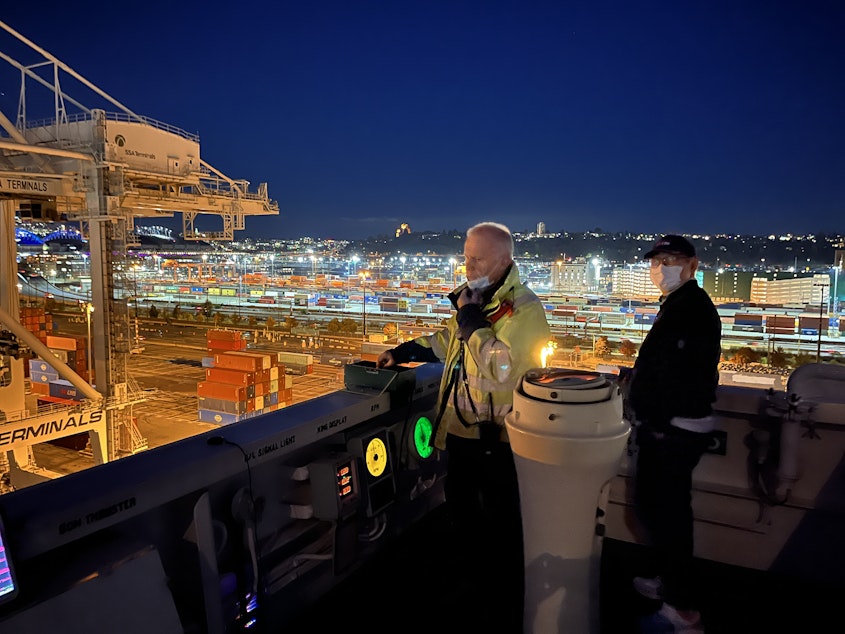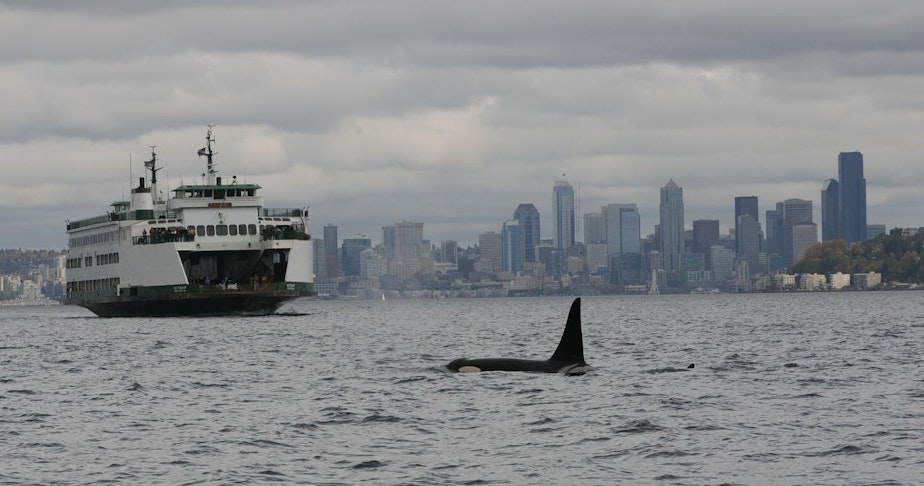Reducing collisions between ships and whales? There are apps for that — but they need work
Fortunately, it doesn't happen very often in the Pacific Northwest that ships collide with whales. But when it does, it's upsetting, tragic and the whale probably dies. Three separate teams have developed smartphone-based systems that can alert commercial mariners to watch out, slow down or change course when whales have been sighted nearby. A recent ride-along on a big container ship demonstrated that real-time whale alerts are still a work in progress.
Puget Sound Pilot Jostein Kalvoy got the assignment to guide the 1,000-foot container ship SM Yantian out to sea from the Port of Seattle on a Friday evening in late October. The ship’s bridge, 15 stories above the waterline, buzzed with the crackle of radios and clipped conversations in the crew's native languages of Korean and Indonesian when Kalvoy came onboard.
Captain Kalvoy soon had a lot to juggle: coordinating the tugboats, ordering the right amount of engine power, cuing the helmsman and watching the cross traffic of ferries and fishing boats. Plus, as if that weren't enough, an app on his smartphone told him critically endangered Southern Resident killer whales were sighted in the shipping lanes an hour to the north earlier in the day.
"If you see them, or you see a report, you want to make sure you keep alert and stay away from them, out of their path," Kalvoy said.
It's dark out by the time the ship passes Whidbey Island at reduced speed, that being the area where the endangered orcas were spotted earlier.
Sponsored

Sponsored
"I'm taking a look at the WRAS -- the Whale Report Alert System app,” Kalvoy explained as he consulted a digital map on his smartphone specially designed for commercial mariners. “I don't see anything, so I'm going to switch to a second app."
That second app was another proprietary whale locations map. It drew upon the latest sightings from commercial whale watching tour captains. The Pacific Whale Watch Association trade group lets the Puget Sound Pilots and state ferry captains use the PWWA app for free.
"We see there was a sighting this morning, about 10 hours ago," Kalvoy noted when he scanned the PWWA app for icons representing whales near the real-time location of his ship.
But the pressing question remained, where were the endangered orcas at the moment? At this point, I pulled up a third app named simply Whale Alert. It collects and shares sightings from the general public, mainly those submitted to the nonprofit Orca Network for now. On this night, the third app happened to have the most recent report. It showed the orca pod, 25 killer whales strong, had moved into Saratoga Passage, well out of the shipping channel.
"Safer for them, safer for us," observed Kalvoy with some satisfaction. But the ship pilot added that he can't do his job and simultaneously cross-reference three different whale apps.
Sponsored
"You can easily lose situational awareness once you get into the depths of it," Kalvoy said. "All of a sudden the minutes tick away and your focus becomes whale reporting and not navigating. That's not really what we want."
Where things get sticky
"One of our frustrations is there has got to be an easier way. It shouldn't matter where the information is coming from, as long as you're getting the information,” said Erin Gless, executive director of the Pacific Whale Watch Association, in an interview a few days later.
Most days, her group's technology displays the largest number of recent whale sightings. Gless said the PWWA has been asked multiple times to share that data with WRAS, the separate, restricted app for commercial ship captains. Gless insists on reciprocity -- if we give you our sightings, we want yours. The answer back from WRAS’ British Columbia-based operator, the conservation group Ocean Wise, is no dice.
"The hesitation there is of course that because we are professional whale watching vessels, if we know where the whales are, we will likely go look at those whales, which is a true statement,” Gless explained.
Sponsored
Gless said her group is also cautious about sharing the PWWA's valuable data due to uncertainty about how it might be used beyond whale notifications to the masters of large ships and ferries.
“There are still a lot of question marks there,” Gless said, for example about whether regulators or parties opposed to boat-based whale watching might get their hands on location histories.
Gless said professional whale watchers are required as a condition of tour boat licensing to report Southern Resident killer whale sightings specifically to WRAS, and the operators are doing so.
The leader of a Seattle-based nonprofit that promotes shore-based whale watching, Donna Sandstrom, said she is at times “heartsick” by how hard it is to break down the silos holding near real-time whale sightings data.
“Our overriding concern is that large vessel operators and Washington Fish and Wildlife enforcement have the data they need as soon as possible,” said Sandstrom, executive director of The Whale Trail.
Sponsored
Sandstrom, as well as another deeply invested figure, Scott Veirs of Orcasound, said one way that people from all walks of life can contribute to the survival of endangered Pacific Northwest orcas is to report whale sightings to their local sightings network.
Someone else who's been trying to get all the involved industries and humans to collaborate is Rachel Aronson of Seattle. She leads the government-funded Quiet Sound project to reduce vessel impacts on killer whales.
"My long-term dream, about 3 to 5 years out, I'd love to see us having a really active human user community, hydrophones actively reporting their spottings of whales,” Aronson said. “And then we want to start trialing infrared cameras that can spot whales from the surface when they are not singing underwater and in the dark and rain when there are fewer humans out there keeping an eye out for them."
That longer term vision requires artificial intelligence to process the feeds from the underwater microphones and the infrared cameras, the latter mounted on top of lighthouses perhaps. In the near term, Aronson foresees a major improvement from a new data sharing agreement. She said programmers behind the scenes are working to automatically import sightings from Orca Network’s shore-based observers (now available through the Whale Alert app) into the restricted app for captains of commercial vessels.
Ships strikes kill a variety of Northwest whales
Sponsored
The risk of fatal ship strikes becomes all too real at least a couple times each year in the waters of the Salish Sea. Last month, a dead minke whale was found floating near Orcas Island with severe bruising and broken vertebrae and ribs, likely from a ship strike according to the West Coast Marine Mammal Stranding Network.
This past March, a rare fin whale that had earlier visited Puget Sound, washed up dead near Pender Harbour, northwest of Vancouver, British Columbia. A necropsy conducted by Fisheries and Oceans Canada surmised the 40-foot whale died of blunt force trauma, most likely from a ship strike.
In 2017, a fin whale was discovered impaled on the bow of a cargo ship in Tacoma's Commencement Bay. The freshly killed whale was likely struck a little earlier on the inbound voyage, perhaps in the Strait of Juan de Fuca.
In the summer of 2021, boaters found the corpse of a humpback whale floating off Vancouver Island near Swiftsure Bank with deep lacerations consistent with injuries from the propeller of a large ship. Car ferries collided with young humpback whales near Mukilteo, Washington, in spring 2020, and near the Seattle and Tsawwassen, British Columbia ferry terminals in spring 2019 -- likely causing the deaths of the whales in each case, though the bodies sank and disappeared before they could be examined. Washington State Ferries and BC Ferries were among the first adopters of the WRAS app in the Pacific Northwest.
The Canadian Coast Guard recently established what it called "a first-of-its-kind Marine Mammal Desk" at its vessel traffic center in Sidney, B.C. The watch stander on the marine mammal desk monitors all sources of real-time whale sightings and then sends out alerts to specific ships as necessary. Several whale advocates have suggested the U.S. Coast Guard establish a similar whale desk at its marine traffic coordination center in Seattle, but the Coast Guard is not biting absent direction to do so from the other Washington.

Copyright 2022 Northwest News Network

